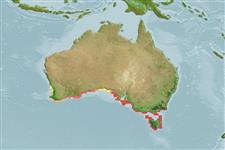Classificação / Names
Nomes comuns | Sinónimos | Catalog of Fishes(Género, Espécies) | ITIS | CoL | WoRMS | Cloffa
>
Gobiiformes (Gobies) >
Gobiidae (Gobies) > Gobionellinae
Etymology: Nesogobius: Greek,nessa = island + Latin, gobius = gudgeon (Ref. 45335); maccullochi: Named after A.R. McCulloch, formerly Curator of Fishes at the Australian Museum (Ref. 76773).
Eponymy: Allan Riverstone McCulloch (1885–1925) was a noted Australian ichthyologist. [...] (Ref. 128868), visit book page.
More on authors: Hoese & Larson.
Environment: milieu / climate zone / depth range / distribution range
Ecologia
marinhas; estuarina demersal; intervalo de profundidade 0 - 1 m (Ref. 76773). Subtropical
Distribuição
Países | Áreas FAO | Ecossistemas | Ocorrências | Point map | Introduções | Faunafri
Eastern Indian Ocean: Tasmania, Victoria and South Australia
Tamanho / Peso / Idade
Maturity: Lm ? range ? - ? cm
Max length : 6.9 cm SL macho/indeterminado; (Ref. 76773); 6.4 cm SL (female)
Descrição breve
Chaves de identificação | Morfologia | Morfometria
Espinhos dorsais (total) : 7; Raios dorsais moles (total) : 5 - 8; Espinhos anais: 1; Raios anais moles: 7 - 10. This species is distinguished by the following characters: 1st D VI-VIII, usually VII; 2nd D usually I, 8-9; A usually I, 8, branched caudalfin rays usually 10; pectoral fin 17-21, rarely 21; an anterior nasal pore medial to and slightly below level of each anterior nostril and a posterior nasal pore by each posterior nostril, a median anterior interorbital pore between front of eyes, a median posterior interorbital pore between end of eyes, an infraorbital pore behind each eye and a lateral canal pore along dorsal part of operculum, no preopercular pores; wide gill opening extending to below posterior preopercular margin; top of head scaled to behind eyes, in 11-18 rows, from 1st dorsal-fin origin; a small patch of scales near dorsal margin on the operculum and preoperculum (sometimes absent on preoperculum), remainder of head without scales; ctenoid body scales, in 37-49 rows; pectoral base and area before pelvic fin scaled (about 15 rows); 1st dorsal fin with rounded or triangular margin (Ref. 76773).
Found on sandy areas in bays and estuaries, from the intertidal to depths of a few meters (Ref. 76773)
Life cycle and mating behavior
Maturidade | Reprodução | Desova | Ovos | Fecundidade | Larvas
Hoese, D.F. and H.K. Larson, 2006. Description of two new species of Nesogobius (Pisces: Gobioidei: Gobiidae) from Southern Australia. Mem. Mus. Victoria 63(1):7-13. (Ref. 76773)
Categoria na Lista Vermelha da IUCN (Ref. 130435: Version 2024-1)
Utilização humana
Ferramentas
Relatórios especiais
Descarregue XML
Fontes da internet
Estimates based on models
Preferred temperature (Ref.
123201): 13.4 - 18.1, mean 16.3 °C (based on 141 cells).
Phylogenetic diversity index (Ref.
82804): PD
50 = 0.5625 [Uniqueness, from 0.5 = low to 2.0 = high].
Bayesian length-weight: a=0.01000 (0.00353 - 0.02836), b=3.08 (2.84 - 3.33), in cm total length, based on LWR estimates for this (Sub)family-body shape (Ref.
93245).
Nível Trófico (Ref.
69278): 3.4 ±0.4 se; based on size and trophs of closest relatives
Resiliência (Ref.
120179): Elevada, tempo mínimo de duplicação da população menor que 15 meses (Preliminary K or Fecundity.).
Fishing Vulnerability (Ref.
59153): Low vulnerability (10 of 100).
